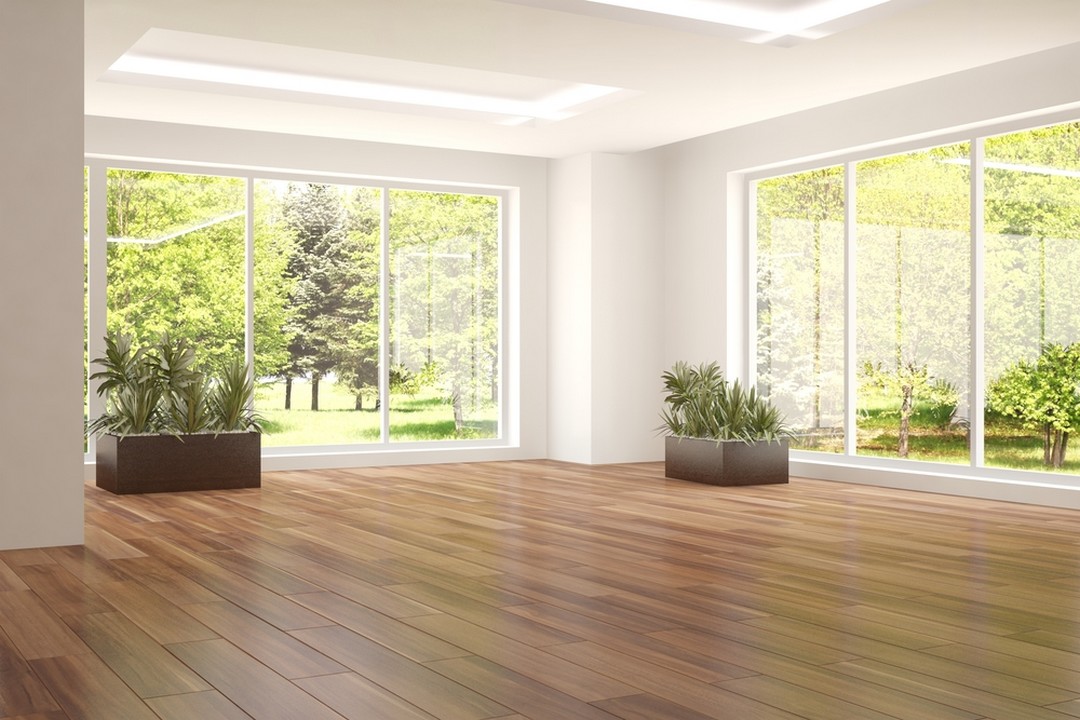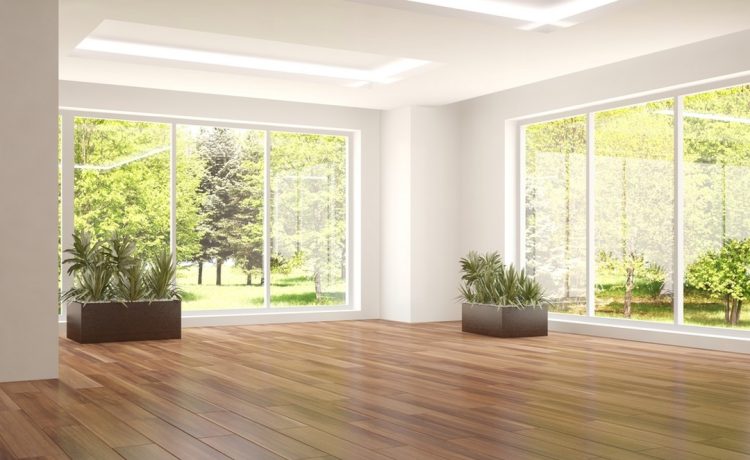To keep hardwood floors looking beautiful and maintaining their shine, it’s important to clean them regularly and systematically. Floors endure significant wear and tear, accumulating dust, dirt, grime, and debris from both the outside environment and indoor activities, such as wearing shoes indoors.
Allowing hardwood floors to become excessively dirty not only leads to an unclean and unsanitary environment but also risks damaging the wood itself. Repairing, refinishing, or replacing damaged wood can be expensive. By implementing a regular cleaning routine using simple tools and natural products, you can extend the lifespan of your hardwood floors. Follow these tips for naturally cleaning hardwood floors, provided by Melissa Witulski, the business operations manager for Merry Maids.
How Often to Clean Hardwood Floors
Lightly clean hardwood floors a few times a week to maintain their cleanliness. Once a month, or more frequently if needed, deep-clean and mop the floors to restore their luster. Choose an appropriate time for cleaning hardwood floors when foot traffic will be minimal, such as when everyone is out of the house.
Witulski recommends performing quick regular cleanings a couple of times per week to prevent excessive dirt buildup: “The most effective method for cleaning hardwood floors is to use a microfiber dust mop, which will gently remove dust, dirt, and other particles that have been brought into your home. Unlike some vacuums, a microfiber dust mop won’t scratch your floors.”
Considerations Before You Get Started
Check the Floor Sealing: Before proceeding with cleaning hardwood floors, it’s crucial to determine the type of finish on the flooring. Check if the floor is sealed with a polyurethane finish. You can perform a simple water test to confirm this. Place a drop of water on the surface of the floor and observe. If the water sits on the surface without being absorbed, it indicates a sealed floor. In such cases, you can safely use water-based cleaning solutions or even steam cleaners.
Limit Water Usage for Unsealed Floors: If the drop of water is absorbed quickly, it suggests that the sealant is worn away or never applied. In the case of unsealed floors, it’s important to minimize water usage during cleaning. Witulski advises, “When you need to perform a deeper clean, use a damp microfiber cloth as needed, and ensure to dry the area immediately with a dry microfiber cloth.”
Invest in a Quality Vacuum Cleaner: For homes with a substantial amount of hardwood flooring, it may be worthwhile to invest in a cordless vacuum cleaner specifically designed for hardwood floors. The Dyson Omni-Glide+, for example, is highly regarded as one of the top vacuum models available. If you have pets, look for a vacuum that is effective at removing pet hair and is also suitable for hardwood floors. Alternatively, for a more hands-free approach, consider a robot vacuum that is designed to clean both hard surfaces and carpets. Some robot vacuums even have mopping capabilities, making them a versatile option for hardwood floors.
How to Clean Hardwood Floors With Vinegar
Cleaning hardwood floors with vinegar is a popular and effective natural cleaning method that can help maintain the beauty and shine of your floors. Vinegar is a versatile household ingredient that acts as a gentle yet powerful cleaner. However, it’s important to use vinegar properly and follow the recommended guidelines to ensure the best results and protect the integrity of your hardwood floors.
Here’s a step-by-step guide on how to clean hardwood floors with vinegar:
- Prepare the Cleaning Solution: Mix a solution of vinegar and water in a bucket or spray bottle. The recommended ratio is one part vinegar to four parts water. For example, you can mix one cup of vinegar with four cups of water. This diluted vinegar solution is safe for most hardwood floors.
- Sweep or Vacuum the Floor: Before applying the vinegar solution, remove any loose dirt, dust, or debris from the floor. Use a broom, dust mop, or vacuum cleaner with a soft brush attachment to gently sweep or vacuum the entire area. This step prevents scratching the floor while cleaning.
- Test in a Small Area: Before applying the vinegar solution to the entire floor, it’s advisable to test it in a small, inconspicuous area. This helps ensure that the vinegar doesn’t have any adverse effects on the finish or color of the hardwood. Apply a small amount of the vinegar solution to the test area and wait for a few minutes. If there are no visible changes or damage, you can proceed with the cleaning.
- Apply the Vinegar Solution: Dampen a microfiber mop or cloth with the vinegar solution. Make sure it’s not soaking wet, as excess moisture can damage the wood. Wring out the mop or cloth thoroughly, leaving it slightly damp. Start mopping the floor in small sections, working your way across the room. Be sure to follow the grain of the wood to avoid streaking.
- Pay Attention to Stubborn Stains: For stubborn stains or spots, you can apply a slightly stronger vinegar solution directly to the affected area. Let it sit for a few minutes to loosen the stain, then gently scrub with a soft brush or cloth. Avoid using abrasive materials that can scratch the wood.
- Dry the Floor: After cleaning, it’s important to remove any excess moisture from the floor. Use a clean, dry microfiber cloth or mop to dry the surface. Ensure there is no standing water left on the floor, as prolonged exposure to moisture can damage the wood.
- Optional: Apply a Protective Finish: If desired, you can apply a protective finish or polish specifically designed for hardwood floors. This helps restore shine and provides an additional layer of protection against scratches and wear. Follow the manufacturer’s instructions for application and drying times.
Remember, while vinegar is generally safe for most hardwood floors, it’s essential to check the manufacturer’s recommendations and warranty guidelines. Some types of finishes or specific hardwood species may not be compatible with vinegar or acidic solutions. If in doubt, consult the flooring manufacturer or a professional for advice.
Regular maintenance and preventive measures, such as using rugs or mats in high-traffic areas and promptly wiping up spills, will also help preserve the beauty and longevity of your hardwood floors.

How to Clean Hardwood Floor Cracks
Cleaning hardwood floor cracks is an important part of maintaining the overall cleanliness and appearance of your hardwood floors. Cracks can accumulate dirt, debris, and even liquid spills, which can lead to staining, discoloration, or damage if not properly cleaned. Here’s a step-by-step guide on how to clean hardwood floor cracks effectively:
- Clear the Area: Remove any furniture, rugs, or objects that may obstruct access to the floor cracks. This will allow you to thoroughly clean the cracks without any obstructions.
- Sweep or Vacuum the Cracks: Start by sweeping or vacuuming the cracks to remove loose dirt, dust, or debris. Use a soft-bristle broom or a vacuum cleaner with a brush attachment to gently clean the cracks. Be careful not to apply too much pressure to avoid scratching the floor surface.
- Use a Cleaning Solution: Prepare a cleaning solution by mixing warm water with a gentle hardwood floor cleaner. Follow the manufacturer’s instructions for dilution ratios and recommended products. Avoid using harsh chemicals, abrasive cleaners, or excessive amounts of water, as they can damage the wood.
- Dampen a Cloth or Sponge: Dampen a soft cloth or sponge with the cleaning solution. Wring out any excess moisture to prevent oversaturation. The cloth or sponge should be slightly damp, not dripping wet.
- Clean the Cracks: Gently scrub the cracks using the damp cloth or sponge. Focus on the areas where dirt or stains are present. Use light pressure and circular motions to lift the dirt and grime from the cracks. Be thorough but gentle to avoid causing any damage.
- Dry the Cracks: After cleaning, use a dry cloth or towel to remove any residual moisture from the cracks. Ensure that the cracks are completely dry to prevent moisture from seeping into the wood and causing potential damage or warping.
- Apply Wood Filler (Optional): If you have deeper or wider cracks that are difficult to clean or that affect the appearance of the floor, you may consider using a wood filler. Choose a wood filler that matches the color of your hardwood floor. Follow the manufacturer’s instructions to apply and smooth the filler into the cracks. Allow it to dry completely before proceeding.
- Seal or Finish (Optional): If desired, you can apply a sealant or finish specifically designed for hardwood floors to further protect the cracks and the surrounding area. Follow the manufacturer’s instructions for application and drying times. This can help prevent future staining and make cleaning easier.
Regular maintenance, such as sweeping or vacuuming, and promptly wiping up spills or stains, can help prevent dirt and debris from accumulating in the cracks. By regularly cleaning the cracks and maintaining the overall cleanliness of your hardwood floors, you can preserve their beauty and extend their lifespan.






